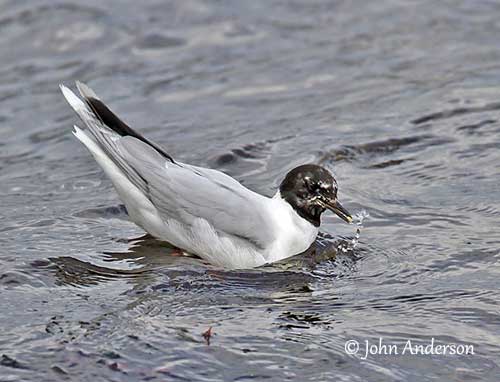
Fr: Mouette pygmée
Ang: Little Gull
All: Zwergmöwe
Esp: Gaviota Enana
Ita: Gabbianello
Nd: Dwergmeeuw
Sd: dvärgmås
Photographers:
John Anderson
John Anderson Photo Galleries
Otto Plantema
Trips around the world
William Price
PBase-tereksandpiper & Flickr William Price
Ingo Waschkies
Bird Photography
Text by Nicole Bouglouan
Sources:
HANDBOOK OF THE BIRDS OF THE WORLD Vol 3 by Josep del Hoyo-Andrew Elliott-Jordi Sargatal - Lynx Edicions - ISBN: 8487334202
THE HANDBOOK OF BIRD IDENTIFICATION FOR EUROPE AND THE WESTERN PALEARCTIC by Mark Beaman, Steve Madge - C. Helm - ISBN: 0713639601
ENCYCLOPEDIE DES OISEAUX DE FRANCE ET D’EUROPE – de Peter Hayman et Rob Hume - Flammarion – ISBN : 2082009920
THE COMPLETE BOOK OF BRITISH BIRDS – Written by “Royal Society for the Protection of Birds” experts - Préface de Magnus Magnusson - Michael Cady- Rob Hume Editors - ISBN: 0749509112
All About Birds (Cornell Lab of Ornithology)
Bird Web (Seattle Audubon Society)
What Bird-The ultimate Bird Guide (Mitchell Waite)
South Dakota Birds and Birding – (Terry L. Sohl)
Little Gull
Hydrocoloeus minutus
Charadriiformes Order – Laridae Family
INTRODUCTION:
The Little Gull is the smallest gull in the world. This species breeds mainly in Scandinavia and E Europe, although some pairs are also breeding in the Great lakes of North America. It migrates S after the breeding season. It usually frequents freshwater or brackish lakes, and nests in wet habitats with abundant fringing vegetation. It is more frequently seen along coasts during winter.
The Little Gull is slowly extending its breeding range westwards, and its population is suspected to be increasing. It is not globally threatened.

DESCRIPTION OF THE BIRD:
Biometrics:
Length: 25-30 cm
Wingspan: 74-79 cm
Weight: 120 g (88-162)
The Little Gull in breeding plumage has blackish hood with no white eye-crescents.
On the upperparts, mantle, back and upperwing are pale grey, and there is a white trailing edge. The primaries are paler grey and white-tipped, with no black. The tail is white.
On the white underparts, the underwing is blackish with contrasting white trailing edge. The breast is often washed pink.
The bill is reddish-black. The eyes are dark brown. Legs and feet are red.
Male and female are similar.
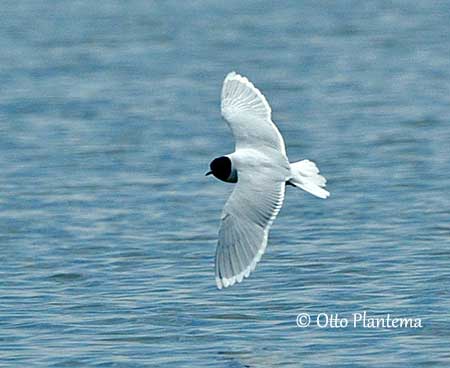
The adult in winter has white head with blackish hind crown and ear spot.
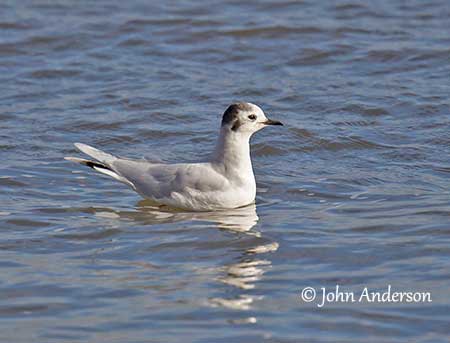
The juvenile has much blackish on head, neck and back, black outer primaries and black “zig-zag” pattern across wing-coverts to rear scapulars. The white tail shows black terminal band. The underwing is pale.
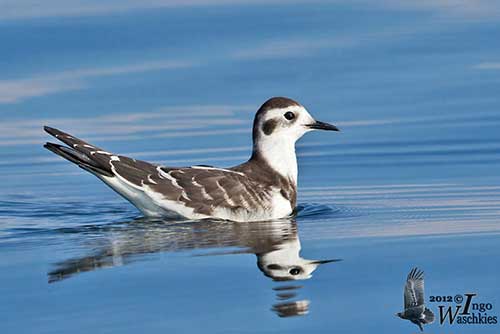
The first winter has still the black “zig-zag” pattern above, but the back is grey.
The second winter resembles adult but it has some black wingtips and paler underwing.
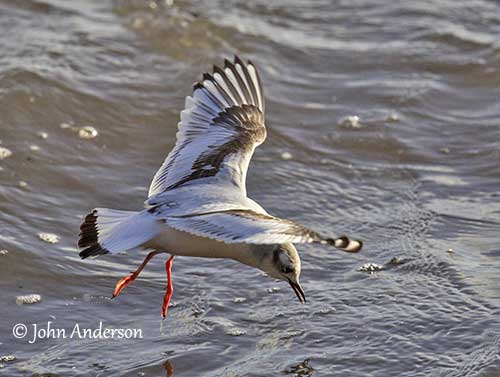
RANGE:
The Little Gull breeds in N Scandinavia, Baltic countries and W Russia to W Siberia, then E Siberia, E from Lena Basin and L Baikal. It also breeds sometimes in W and C Europe, and in North America, in the Great Lakes and Hudson Bay.
It migrates S after breeding to spend the winter in S and W of the breeding range in Mediterranean, Black Sea and Caspian Sea, but also along the coasts of W Europe and E USA.
HABITAT:
The Little Gull breeds mostly inland around lowland freshwater lakes and marshes with abundant fringing vegetation. It also breeds in fresh or brackish coastal marshes.
Outside breeding season, it occurs mainly along coasts, especially at protected shallow estuaries, adjacent freshwater or brackish lakes, mudflats and beaches. During migration, it is often seen at inland lakes.
CALLS AND SONGS: SOUNDS BY XENO-CANTO
The Little Gull’s usual call is a short, soft “kik-kik”. During the displays, it gives a shrill “ke-kay, ke-kay, ke-kay…”
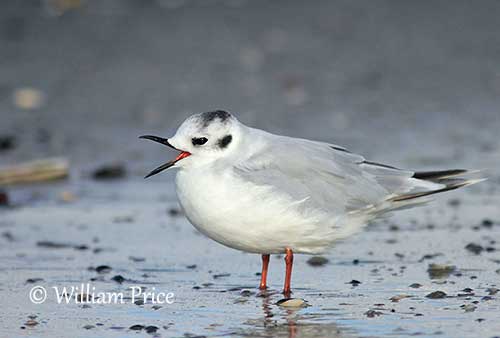
BEHAVIOUR IN THE WILD:
The Little Gull feeds mainly on insects during summer and migration. But it also consumes crustaceans, small molluscs, marine worms, small fish and spiders.
It flies slowly and low while dipping to water surface or ground, and picks up food items. It also hovers in the air and plunge-dives occasionally. It also lands on water to feed, or wades in shallow water.
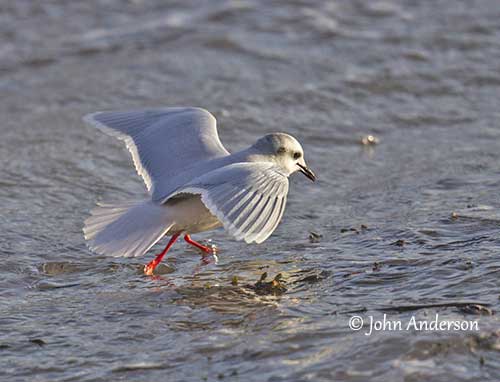
During the breeding season, the Little Gull performs courtship displays. The pairs form before to reach the breeding colonies.
During courtship, the birds walk around each other with their heads tilted away, in order to expose the black hood. Then, they perform preening or pecking at ground.
They nest in small colonies, but sometimes up to 1000 pairs. Some pairs may nest in scattered pattern too.
In front of an intruder, the gull holds the head upright, again to display the black hood.
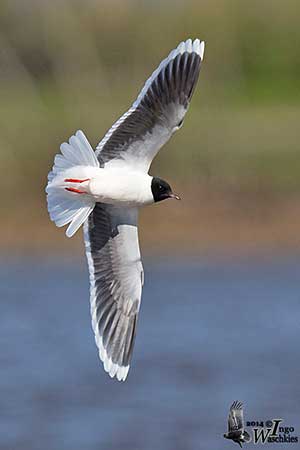
The Little Gull is migratory. The autumn migration is reported in the North Sea and N France in July/November, with peak in late October. Numerous immatures are present in the Netherlands in autumn.
The spring migration is usually rapid and less conspicuous than in autumn. The E Asian population winters from the Sea of Okhotsk to E China. Vagrants may reach Africa in winter, but also Pakistan, India and SE Asia.
In North America, movements occur around Great lakes in summer and on Atlantic coasts in winter, with probably movements between these two areas.
The Little Gull has bounding flight. The flight action is quick and agile, with several rapid wingbeats.
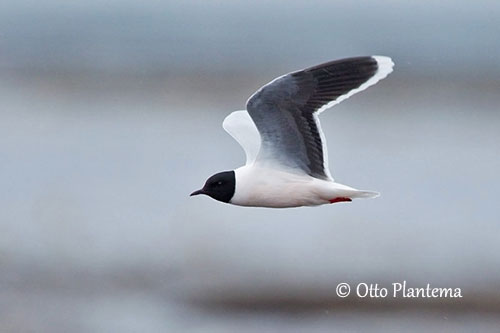
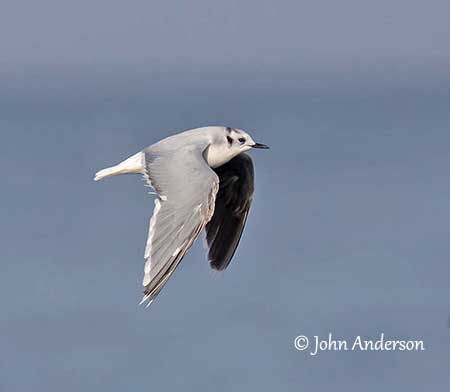
REPRODUCTION OF THIS SPECIES:
The laying starts from late June. The Little Gull breeds in small colonies or in scattered pairs. It may nest with other species, with nests 1/1,5 metres apart.
The nest is on the ground, usually near water in marshes. Both adults build a shallow depression in wet vegetation, lined with grass and leaves, or reeds.
The female lays 2-3 olive/buff eggs with brown and grey markings. Both adults share the incubation during 23-25 days. The chicks have grey-buff down with black spots on crown and back, and whitish underparts. They are fed by their parents and leave the nest a few days after hatching, but they remain in the surroundings. They are able to fly at 21-24 days old, and they leave the nesting-site in family group, but they are independent very soon. They can breed at 2-3 years old.

PROTECTION / THREATS / STATUS:
The Little Gull has increasing population estimated at 97,000/270,000 individuals (2006), although the European population is suspected to be declining.
In North America, the species is scarce and local, with an estimate of 100/200 breeding birds. This population has increased since the 1960s.
The Little Gull is currently evaluated as Least Concern.
